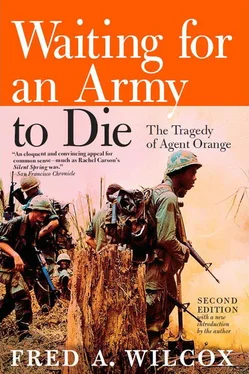By establishing a “buffer zone” between areas to be sprayed and sources of water, the Forest Service and other proponents of herbicides have been able to rationalize the use of substances contaminated with dioxin. Theoretically this zone will keep herbicides and herbicide contaminants from entering the drinking water or food chain, but in reality the Oregon coastal area has been a herbicidal free-fire zone for a number of years. Theoretical buffer zones, explains Hill, do not prevent area residents from being exposed directly to herbicides. “Right after we sent our letter to the EPA an environmental group in Portland tried to get the buffer zones increased, but 75 percent of the State Board of Forestry is composed of timbermen, so needless to say the proposition failed. And just because the EPA temporarily suspended certain uses of Silvex and 2,4,5-T doesn’t mean the spraying of herbicides hasn’t continued. Just this year, for example, a woman was at her house one afternoon and there’s a helicopter spraying across, just about a quarter of a mile from her house. And she had all of her windows open because it was a beautiful day, although quite windy, and all of a sudden she smells something and she knows it’s a herbicide. So she gets on the phone and she tries to find out who it is that’s spraying, but she can’t find out. And she makes several telephone calls, and all of a sudden it’s five o’clock and all of the offices are closed. She calls the Forest Service and they can’t help her, even though all the helicopters use the same helipad, all of them .
“She calls the State Board of Forestry, which is supposed to have the permits for everybody, and they can’t help her. She calls a few private companies, and she can’t find out. Everybody’s closed over the weekend, and finally it’s Monday afternoon when she finds out the name of the company that has sprayed. Meanwhile, she has become very sick and her children are very sick. Her nose and throat were burning, her eyes were irritated, and her son was vomiting.”
Four days later, on a Tuesday morning, the company responsible for the spraying sent someone to take blood and urine samples, which, when tested for residues of herbicides, turned out negative.
“But this is meaningless,” says Hill, who has delegated the dessert-making to her teenage daughter and, having poured us each a second cup of coffee, is seated across from me at a table in the home-economics room. “There’s a doctor in Coos Bay who has worked for some time with people who’ve been exposed to herbicides, and he points out that just because they don’t find traces in your blood or urine doesn’t mean it isn’t someplace else in your body. For example, dioxin is stored in fat tissue. And even if the herbicide has passed through your body there’s no proof that it hasn’t done some damage in passage. An X-ray also passes through your body, but it can do some damage as it travels through. But of course this is all hearsay, you know. In a court of law it would be just that—hearsay.”
One of the most fascinating and incriminating aspects of the history of herbicide use is that whether reports have come from Vietnamese peasants, Oregon housewives, Arizona potters, or mothers living near the Long Island Rail Road, complaints about the effects of 2,4,5-T on humans and animals have been remarkably similar.
In Minnesota, a homesteader who had searched for five years to find land that had not been sprayed with chemicals fired a shotgun at a Forest Service Helicopter. But according to columnist Jack Anderson:
It returned the next day and thoroughly sprayed the forest adjoining the land. Subsequent testing of his water supply by Minnesota health authorities showed traces of herbicide containing dioxin.
Within a few days of the spraying, his family suffered headaches, nausea, dizziness and diarrhea…
Another horror story is told by Neddie Freedlund, a farm wife in Wisconsin. After a neighbor sprayed his land with 2,4,5-T, she reports her entire family was seized with intense bellyaches, fever and sleeplessness.
Her baby began screaming in agony and pulling his hair until bald spots appeared. She subsequently has suffered three miscarriages although she had previously borne six healthy children.
Freedlund also claims that similar maladies affected her barnyard. There was a dramatic decline in the quantity and quality of the milk produced by two cows. Her pigs gave birth to piglets that were either abnormally large or small. Rabbits had premature and deformed offspring. 3
In his paper “The Effects of Herbicides in South Vietnam,” Dr. Gerald C. Hickey—who was affiliated with Cornell University’s Southeast Asia Program when the paper was published by the National Academy of Sciences, National Research Council—describes the effects of defoliants on Vietnamese highlanders. The highlanders’ descriptions of the effects of herbicides on their land, animals, and their own health are in many cases similar to those of Americans who have been exposed to herbicides.
There was a definite pattern in the perceptions regarding the effects of the herbicides on those residing in or near the sprayed zones. The most common symptoms reported were abdominal pains and diarrhea. Informants from Long Djon also reported that in addition to these symptoms, the villagers complained of experiencing a stinging sensation in their nasal passages just after the spray drifted into the settlement. Many developed coughs that lasted more than a month. At Dak Rosa, according to some residents, many villagers went into the swiddens following the spraying, and in addition to the common symptoms noted above, these people broke out with skin rashes that lasted many weeks. Dak Tang Plun residents also reported widespread skin rashes, cramps, diarrhea, and fevers. A Plei Ro-O informant reported these same symptoms, noting that some villagers coughed blood.
Polei Krong informants stated that the villagers suffered these same ailments, that the skin rashes looked “like they had been burned, with small blisters all over the red areas.” Dak Siang informants noted that after some of the villagers drank from the stream which was in the sprayed area, they became ill with abdominal pains and diarrhea that lasted for days. They also reported that some villagers had eaten bamboo shoots from the sprayed area, after which they became dizzy “like you feel when you have drunk too much from the wine jar,” and this was followed by vomiting. Polei Krong residents, according to one informant, fell ill with abdominal pains, diarrhea, vomiting, and fever within one day after the spraying…
A difficult area of inquiry concerned possible deaths due to the herbicides. Sickness and death are common occurrences in highland villages, and infant mortality is particularly high. Some of the informants expressed the opinion that there was an unusually high number of deaths, particularly among children, following the spraying. However, they were very cautious in concluding that the spraying affected childbirth.
Informants from Long Djon had reported a stinging in the nasal passages just after the spray drifted over the settlement, and this was followed by villagers being afflicted with coughs. They added that more children than adults were afflicted, and that “many children died.” The victims developed skin rashes, and those with rashes that did not clear up died. One elderly lady noted that she knew of one stillborn case following the spraying, but she could not say whether it was due to the herbicide (she, like other informants, always pointed out that stillbirths were not unusual in their villagers). At Dak Rosa informants attributed the outbreak of skin rashes to the fact that many villagers went into the swiddens following the spraying. They also noted that some women carried their small children on their back in the fields, and they brushed against leaves containing the “medicine” that had been sprayed. Some of these children subsequently developed bad rashes all over their bodies. They looked, the informants said, “like insect bites,” and all the victims died. One informant knew of three such deaths. Another informant reported knowing of five stillbirths after the mothers, during pregnancy, had worked in the sprayed swiddens. The informants felt that there was an unusually high number of such deaths following the spraying.
Читать дальше











